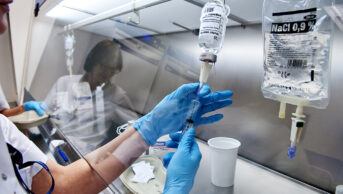
Jochen Tack / Alamy
Adherence to the oral anticoagulant dabigatran varies substantially among clinics and is higher at sites with pharmacist-led monitoring and appropriate patient selection, a US study has found.
Other factors associated with better adherence to dabigatran were lengthier monitoring and more intensive management of non-adherent patients.
The researchers, led by Mintu Turakhia, from the department of cardiology at the VA Palo Alto Health Care System in California, say this underscores the importance of strategies to optimise the efficacy of oral anticoagulation and call for research to test the impact pharmacists can have on adherence.
“With rapid adoption of [non-vitamin K antagonist oral anticoagulants (NOACs)] into practice, randomised trials evaluating the effect of multimodal interventions involving pharmacists on patient adherence are needed,” they say.
The study, published in JAMA
[1]
on 14 April 2015, involved 4,863 patients from 67 Veterans Health Administration sites who collected prescriptions for dabigatran between 2010 and 2012 for non-valvular atrial fibrillation. As part of the study, 47 pharmacists were interviewed.
The median proportion of patients who were adherent to dabigatran (defined as a proportion of days covered of at least 80%) was 74%. In adjusted analyses, adherence across sites varied by a median odds ratio of 1.57.
The researchers analysed a raft of site-level variables and found four factors to be significantly associated with better patient adherence: appropriate patient selection; provision of pharmacist-led monitoring; longer duration of monitoring; and providing more intensive care to non-adherent patients. However, the provision of pharmacist-led education was not significantly associated with dabigatran adherence.
Helen Williams, consultant pharmacist for cardiovascular disease with Lambeth and Southwark clinical commissioning group, says adherence to and persistence with therapy have been concerns since the introduction of NOACs.
“The study demonstrates the valuable role that pharmacists in particular can play in supporting patients at initiation and throughout treatment with a NOAC,” she says, adding that support may be delivered by pharmacists at any point in the patient journey. “For example, as members of the anticoagulation clinic multidisciplinary team within the hospital or primary care settings, or from the community pharmacy providing a new medicine service and medicines use reviews.”
The researchers say that they uncovered site-level variation both in patient adherence to dabigatran and in management strategies, with some sites using pharmacists and others deferring management solely to clinicians.
“These findings suggest that such site-level practices provide modifiable targets to improve patient adherence to dabigatran as opposed to patient characteristics that frequently cannot be modified,” they conclude.
References
[1] Shore S, Ho PM, Lambert-Kerzner A et al. Site-level variation in and practices associated with dabigatran adherence. JAMA 2015;313(14):1443-1450. doi:10.1001/jama.2015.2761.
You may also be interested in

Tell us about your salary and working conditions

Allowing pharmacy technicians to supervise hospital aseptic facilities would increase risk of ‘catastrophic clinical error’, says PDA
